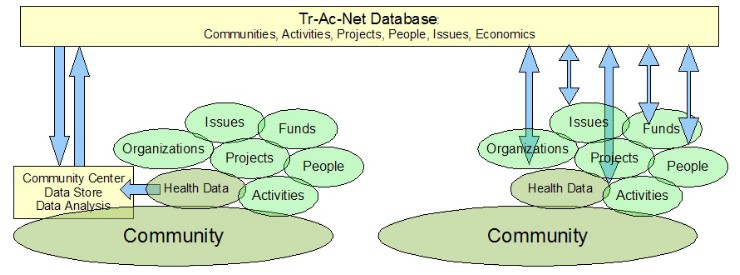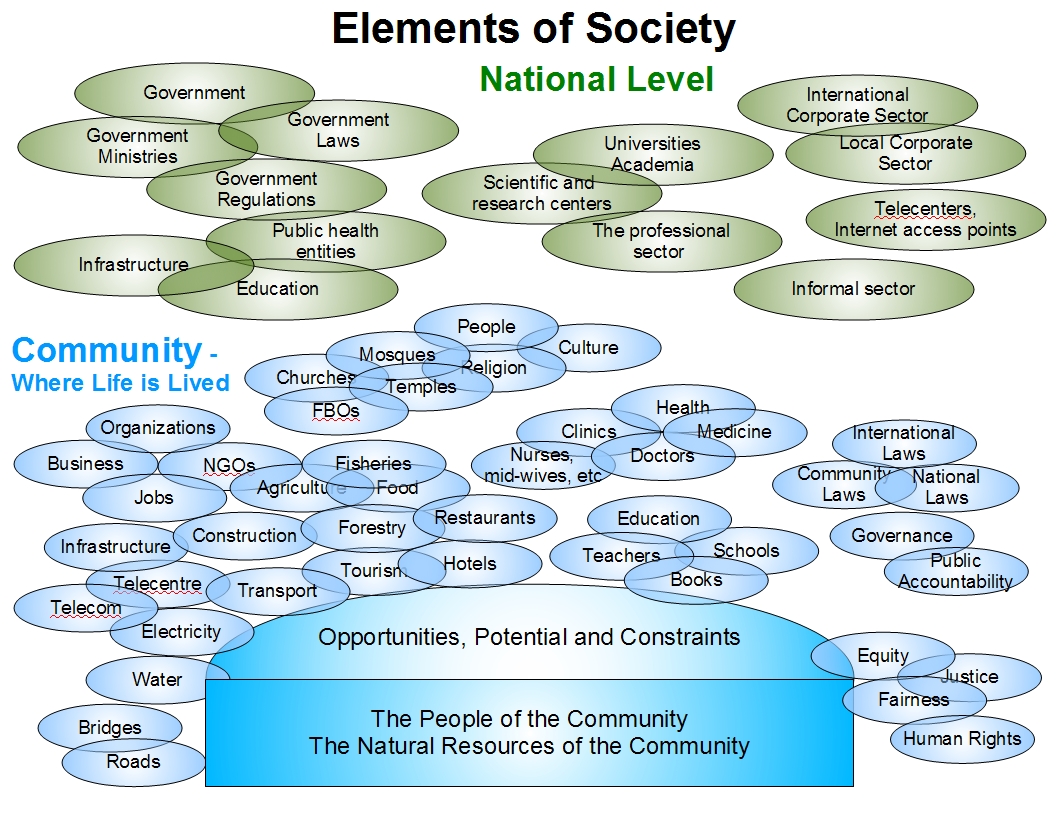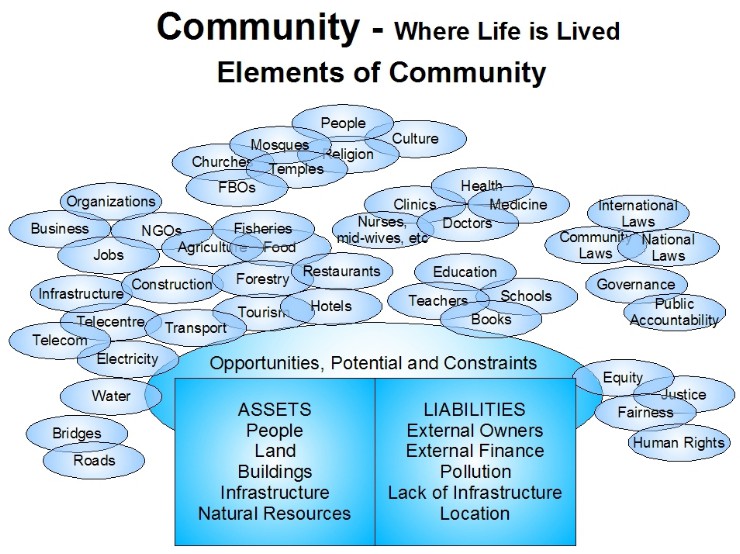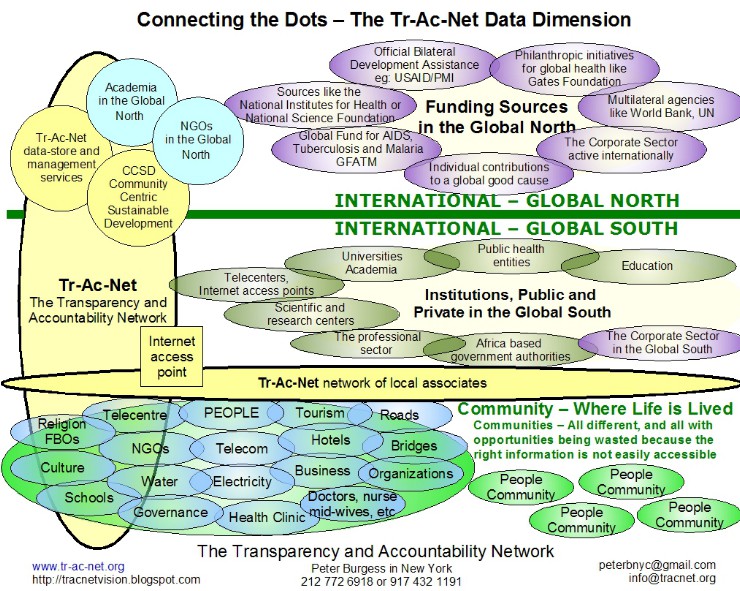FEEDBACK
DATA AND ANALYSIS WITHOUT A FEEDBACK PROCESS IS A COST WITHOUT A BENEFIT
|
|
|
FEEDBACK
Effective feedback is absolutely vital for a stable system. Engineering appreciates the importance of feedback, economics less so. It is also important to understand that fast feedback is very much more powerful than feedback that takes a long time to happen. Most feedback in the modern economy is too slow and rarely specific enough to be of much use. The dataflows in the MDIA framework are designed to be timely and actionable by all decision makers in the system.
|
|

|
This graphic and the next were prepared in the context of Community Centric Sustainable Development more than twenty years ago to illustrate the idea that data should be at the center of all development initiatives starting with the planning phase, and ending with the data that shows impact and the post activity results. The original consulting work was done for the World Bank and the United Nations.
The graphic show how initial status gets improved as a result of the activities ... activities that are planned, organized and implemented based on the data that is centric to everything.
|
|

|
This graohic shows how data should be used to inform decisions at every stage of the process of development investment.
|
|
|
|
EXAMPLE - SOUTHERN STATES FACTORY MANAGEMENT
Personal experience: Southern States is a company that manufactures air-break switches for the electric utility industry. There was a time when I was put in charge of the factory as VP Manufacturing. Previously I had been the Controller in charge of the accounting, purchasing and related admin functions. Nobody expected me to be at all effective in this role (in fact I was being set up to be fired!) but while there was a lot that I did not know about the factory I did know something about cost accounting and management behavior. I change the daily 'production meeting' from 10am to 8am ... the factory shift started at 7.30am ... and changed the agenda from a discussion of yesterday's production to a discussion about the upcoming day's production. In the process we learned about all the problems everyone was facing for the upcoming day, and by 9am the maintenance crews and others were working to fix all of the constraints on today's production. The result was that daily production increased almost threefold without any costly changes to the factory.
Lesson learned: Most dataflows are too slow to be of much use in improving performance. The data are not significantly improved by incremental improvement in accuracy or precision, but the improvement in value is substantial when the dataflow are faster and delivered to people who can use the data to improve performance.
|
|

|
Data at the Center
Date being used to inform all the steps in undertaking a project
... Planning
... Organization
... Implementation
The essential determination of progress is whether or not the final post-activity status is better than the initial status
Personal experience: I have conducted hundreds of reviews of the performance of development projects for the United Nations, the World Bank and others. Many of the projects that were considered successful by the UN, the World Bank who were funding the projects and the various organizations that were implementing the projects. My view of the projects was significantly different because, while the funding and implementing organizations were looking at the activities, I was looking at the results, and specifically whether or not the post activity status was better than the initial status. Using this as the key criteria, very few development projects were successful.
|
|
|

|
Data at the Center
Data should be informing all the decisions that are being made all the time
|
|
|
|
|
MULTIPLE FEEDBACK LOOPS
In most systems there are many decision makers, and for high performance, the dataflow and feedback loop for each of the decision makers should be suited to that point in the decision making process.
Example: People who are responsible for the design and building of road improvements need a very different dataflow and feedback than the people who are currently driving along the highway. Some of the data are the same, but the timing of the dataflow and feedback is completely different.
Example: People who are responsible for production in a factory are concerned with a multitude of oeprational details relatreed to the factory. When all of these are optimized the factory will run at its full potential. The Baord of Directors, on the other hand need to have data that reflects how well the factory is doing in aggregate and how well relative to its potential and how this relates to the need for production fot customers and for bigger potential markets. The BoD and the factory both have the goal of best possible performance, but they have different decision making roles and different dataflow and feedback needs.
Personal experience: As CFO I was responsible for external reporting to stockholders, for reporting to the Board of Directors and for all the analytical reports being used to manage each of the departments of the company. The external annual report with audit was once a year, the unaudited quarterly reports were every three months and all the internal reporting was done once a month. Many of the key internal analytical reports were done once a week, and in some cases every day. All of the data 'nested' together and was completely coherent so that the resulting external reporting was reliable, but the more frequent internal reports were desinged to be useful for performance improvement rather than simply accurate for the purposes of reporting. This data architecture and related reporting meant that the data served both internal purposes and external purposes effectively.
|
|
|
|
PROGRESS AND PERFORMANCE ... SUCCESS IN SHENGE
Success with a multi-sector focus
Most community development “projects” do not have much thoughtfulness about how best to use scarce resources. I have helped evaluate hundreds of projects, and almost all of then failed because they were limited to a single sector, and though well designed with respect to the single sector, completely ignored the impact that failure in any of the other sectors would have.
Personal experience: The FAO Project in Shenge, Sierra Leone (c1989).
I did an evaluation of an FAO fisheries community development project in Shenge, Sierra Leone. It was multi-sector and implemented with continuous performance improvement for the community.
It would have created an amazing level of durable value for the community if the country itself had been sustainable. This project took resources and made the best possible use of them. It was wonderfully successful ... so much so that the two expatriate CTOs were honored with chieftaincies by the local community. This project worked on the basis of doing what is best for the community ... using scarce resources in the best possible way, and the results were remarkable.
This project used its rather limited resources and created community benefit that was perhaps as much as 100 times more than was anticipated for the project. How was this achieved? Two very competent expatriate Chief Technical Officers (CTOs) controlled the money and used it to do what would deliver a lot of value in the community ... and people paid for it.
Economics 101 says, if I remember well, that price is determined by supply and demand. If you offer something that has a good value, people will pay for it, if they possibly can. So everything done by the project had a price, and to the extent that it was valuable people paid for it.
The project funded the purchase of a very valuable inventory of spare parts for fishing boats and outboard motors, and fishing gear. These were not given away, but sold at the local market prices with the money flowing back into the project.
With this money, ther project bought more inventory, and then expanded the scope of its work to solve fuel shortage problems for the outboard motors by installing fuel storage tanks for a substantial inventory of fuel. The fisherfolk went fishing much more rather than having to spend valuable time hunting for fuel, gear and spare parts.
The project trained a mechanic to fix outboard motors, and in turn this mechanic started to train other young men to be mechanics. His salary was paid for by small fees paid by the students, and all of them (teacher and students) then made money by being paid to service the outboard motors in the community.
The same dynamic took place in the fish smoking area. The project planned to teach six local women about fish smoking, but after the initial training, the group expanded into a group of 60 women who were learning these new skills and then applying them in the market, and prospering.
More fish were being caught ... more fish were being processed for the market ... and the community was on its way.
Now the community needed to expand its marketing area, but in the wet season the community was completely cut off because the road was impassable. Maintenance of the road was a 'government' responsibility but this was not happening. The government had a crew of road maintenance workers in the area, but they were usually unpaid and had not materials or equipment to do anything useful. The project advanced some wages for the workers and paid for some material for repairs (gravel, cement, etc) and critical culverts were built and the road made usable in all weathers. The fisherfolk and traders generated enough business and cash to refund the money to the project.
What else could the project do?
A new school had been built in the community some years before funded by IDA (World Bank) but essentially idle because there was no budget for staff and the operation of the facilities. The facilities included diesel electric generators and technical workshops for carpentry, metal work, sewing, etc. The project purchased fuel for the generators and material for the workshops and started to run evening courses for skills training for people in the community.
More and more people were able to learn and earn at the same time ... but also more and more as the community progressed.
When I assessed the performance of this project, it was clear that the results of the project far exceeded the goals of the project as described in the project documents. I wrote up the project as being a great success, and concluded that the results were far better than had been anticipated in the project justification. When I handed in my report, I was shocked that the local UNDP Resident Representative decribed the project as something of a disaster because the project had not followed the detail plans as described in the project document ... which was true. The fact that the progress of the community was many times better than anything that would have been possible slavishly following the project plans, was of little interest to this functionary.
[Follow up not: This particular functionary subsequently had a quite successful career in the UN system and with the World Bank ... evidence that these organizations do not have in place adequate metrics for management.]
|
|
|

|
COMMUNITY FOCUS
When the BDSDA / Tr-Ac-Net initiative was developed circa 1990 it was recognized that every community was different, but also that every community was the same in that there are always many different issues in every community, but in different mixes.
... People: the demographics of the people, and their quality of life and standard of living
... Health: the state of health of the population and the access they have to health services
... Activities
... Projects
... Organizations
... Funds
... Issues
Accordingly, the idea emerged that there needed to be deep knowledge about each and every community. Over time, the thinking about what all the relevant information should be has evolved, but the core concept remains much the same.
... Education: the sate of knowledge in the population and the access they have to education
|
|
|

|
COMMUNITY ... FEEDBACK AND DATAFLOW
The BDSDA / Tr-Ac-Net initiative developed circa 1990 had a focus on the need for data about the community, data that was first and foremost of use in understanding the needs of the community and what was needed to have progress in the community.
This contrasted with how data was being collected and processed by most of the international development assistance community (like the OECD, World Bank, USAID, the UN and others) which tended to aggregate most of their data at the Sector Level and the National Level. Using this methodology the critical differences between places was subsumed into the generalized total and averages.
|
|
|

|
Data at the Center
|
|
|

|
Data at the Center
|
|
|

|
Data at the Center
|
|
|

|
Data at the Center
|
|
|

|
Data at the Center
|
|
|

|
Data at the Center
|
|
|

|
Data at the Center
|
|
|
|

